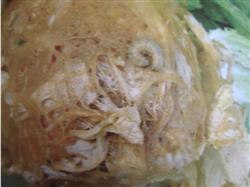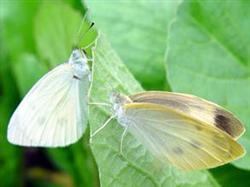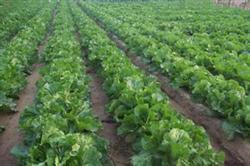How to prevent maggots from autumn cabbage

Autumn cabbage in the growth process, the most avoid ground maggots (also known as root maggots), it bites on the root epidermis of Chinese cabbage, causing germs in the soil to take advantage of it, causing Chinese cabbage to rot, which not only reduces the yield of Chinese cabbage, but also affects the edible value of Chinese cabbage. If it is not controlled in time, the whole field will be damaged and serious losses will be caused to vegetable farmers. The maggot that harms autumn cabbage is the larva of radish fly and is an oligophagous pest, mainly harming cruciferous vegetables such as Chinese cabbage and radish. First, the occurrence characteristics of radish flies occur one generation every year, overwintering as pupae in the soil, and the dormant period is about 10 months. In the second year, the adult occurrence period mainly began in early August and lasted until late September, and the peak period was in the middle and late August. Adults come out in the morning and evening or on cloudy days, and remain motionless in the shade of cabbage plants when the sun is strong at noon. The climate is warm and humid in autumn, and the occurrence is serious. The number of adults increases significantly 1-2 days after rainfall or irrigation. After the adults were unearthed, after about 7 days, they laid eggs in the axils of the first and second leaves and in the topsoil or topsoil crevices around the base of the cabbage plant. The eggs hatched into larvae after 4-7 days, and the larval stage was about 30 days. After this kind of larva appeared, it first ate the base of the petiole near the cabbage root and the vegetable side around it, and then ate the cabbage root, showing curved wormways or holes. The harm was aggravated when the temperature decreased, and it was easy to induce the occurrence of soft rot of Chinese cabbage. Second, prevention and control methods 1. Soil treatment. Before planting Chinese cabbage, 2.5-3.5 kg phoxim granules per mu can be mixed with chemical fertilizer and applied to the soil, which can kill the eggs and larvae of seed flies. two。 Sweet and sour booby traps. The trapping was carried out according to the characteristics of radish fly licking sugar and vinegar. The mixture is made of 0.5 kg sugar, 1 kg vinegar, 7.5 kg water, plus 20 grams of trichlorfon powder. In early August, a bowl-sized pit is dug every 8-10 meters in the field. Put into a plastic bag according to the size of the pit, pour in 100 grams of the mixture, and add the mixture every 10 days or so, which can kill a large number of adults. 3. Spray on the ground. When Chinese cabbage grows to 2-3 true leaves, or 2.5% trichlorfon powder 1-1.5 kg per mu, or 0.5-1 kg dimethoate powder per mu, field ground powder is sprayed to prevent seed flies from entering the field to lay eggs. 4. Apply medicine to the root of vegetables. When Chinese cabbage grows to 6-8 leaves, plant ash, lime powder and 2.5% trichlorfon powder can be mixed at 2:1:1 and sprinkled around the vegetable root to prevent seed flies from laying eggs and kill the larvae before entering the soil. 5. The potion is filled with roots. When it is found that Chinese cabbage in the field is damaged by root maggots, 90% crystal trichlorfon 1000 times, or 40% dimethoate EC 1500 times, or 50% phoxim EC 2000 times can be used to irrigate the roots, each plant is about 200g, so that the liquid flows from the heart of cabbage to the rhizosphere to ensure that the root soil is moist. Topdressing ammonia can also prevent the occurrence of ground maggots. About 30 days after cabbage planting, use 1 kg of ammonia water, add 1 kg of clear water, stir evenly and then irrigate the roots. Each plant is filled with about 150 to 200 grams. Or combined with autumn cabbage irrigation, ammonia water will be slowly poured into the running water for furrow irrigation, which can not only prevent the occurrence of maggots, but also play the role of topdressing.
- Prev

How to prevent early Chinese cabbage from being unprotected?
1. Biological control (1) pay attention to the protection of natural enemy parasitoids, apply borer-killing bacteria (containing 10 billion spores per gram of bacterial powder) 500 × 700 times solution or cyanobacteria 6, B.T. Emulsion, etc. Apply granulosis virus preparation or collect older larvae killed by the virus from cabbage fields (infected larvae lose appetite and blacken body color.
- Next

Early preparation for disease prevention of autumn Chinese cabbage
As the saying goes: head-volt radish, two-volt mustard, stand autumn plant cabbage. Now it is time to plant autumn Chinese cabbage again. We should plant autumn Chinese cabbage in time to ensure high quality and high yield. Now the key points of cultivation techniques of autumn Chinese cabbage are introduced as follows: select varieties with good fertilizer and water conditions, select tall, late and medium-maturing varieties; fertilizer.
Related
- Where is it suitable to grow horseradish in China? it is expected to see the middle altitude horseradish in Alishan.
- How to prevent tomato virus disease reasonably? (Control methods included)
- Many people like to plant towel gourd on the balcony. What are the main points of this method and management?
- What crops can chili peppers be mixed with?
- Fertilization techniques and matters needing attention in Tomato
- What are the grafting techniques for peach seedlings in spring?
- Harm and control methods of root swelling disease of Chinese cabbage
- What are the pests of sweet potatoes? How to prevent and cure it?
- Symptoms, causes and Control methods of navel Rot in Tomato
- The cause of "Cucumber rotten bibcock" in Farmers' planting Cucumber and its Control Plan

